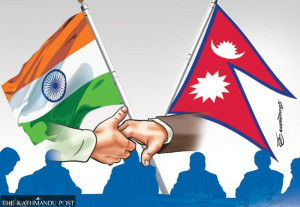Columns
Embracing digital payments
Promoting digital transactions can form a digitally empowered society.
Abhaya Poudel & Riya Shrestha
Digital payments are transforming Nepal as the country experiences a significant shift in its financial landscape. Electronic payment methods are on the rise—whether for big purchases or a cup of tea. This is evident from the QR codes seen almost everywhere, from fancy malls to street-side stalls. The shift from a cash-based to a cashless economy is set to redefine GDP numbers over the next 8-10 years.
The Nepali economy has long been crippled by the shadow economy, including tax evasion at various economic forefronts and informal remittance channels. Based on a 2018 study by Medina and Schneider, on average, the shadow economy made up 30.22 percent of the total Nepali economy in 2015. Cash transactions dominate consumer payments. Due to their untraceable nature, retailers have ample opportunities to underreport sales. This continues upward in the entire supply chain—from retailers to wholesalers, distributors and national importers—allowing importers to avoid paying full duties on imported goods through under-invoicing.
Under-invoicing occurs when the price of goods is reported as much lower than the actual price paid. The excess amount not reported in the invoice is settled through 'hundi,' using foreign currency sent informally by Nepali migrant workers to their families in Nepal. These practices deprive our government of much-needed revenue and distort trade balances.
In Nepal's import-based and remittance-reliant economy, such effects are more pronounced. Remittances contribute to about 25 percent of the GDP and finance nearly 84 percent of the trade deficit. Bringing such unremitted funds through formal channels could significantly increase national income and foreign reserves. As the adoption of digital payments is at the last mile, retail transactions are gradually growing, and new rules are emerging and dictated by how people make payments.
Digital payments are immutable and traceable, compelling retailers to record their full sales value. This transparency has a chain effect, enforcing compliance on wholesalers and importers to report their invoices accurately and avoid evading customs and income taxes. Now, retailers cannot completely revert to cash-based transactions. Digital payments are becoming habitual among consumers. Retailers who continue to rely upon cash transactions may risk losing their customers and potentially going out of business.
Nepal’s digital payments are projected to increase at an annual rate of 30 percent, reaching approximately $11 billion by 2029. This growth will be driven by innovations in the fintech space, increased customer trust in digital payments and supportive government policies. Moreover, cross-border payments are gaining momentum. From 2024, Indian digital wallets such as PhonePe and BHIM UP have been allowed to make payments in Nepal. Similarly, travellers from 10 other countries can make payments in Nepal via NEPALPAY QR codes. Nepal should continue fully integrating into global digital payment networks to enhance economic connectivity and promote trade and tourism.
To decrease the value of the shadow economy, businesses should be brought into the formal economy and encouraged to comply. A multi-stakeholder approach is needed, starting with consumers. As informed and responsible citizens, consumers should actively choose digital transactions over cash payments and contribute to a more transparent financial ecosystem. They should ensure that the payments made to businesses go into retailer’s registered accounts rather than personal bank accounts. This will help improve accurate tax reporting and reduce tax evasion at the retail level.
Likewise, payment service operations (PSOs) and payment service providers (PSPs) should ensure that digital payments are equitable, accessible and affordable for all user groups. This includes developing user-friendly interfaces and educating people on adopting digital transactions. Maintaining security standards and ensuring that customers are well protected in the digital realm remains crucial for garnering customer trust and repeat usage.
Government and regulatory bodies have to implement regulations that encourage the acceptance and usage of digital payments across all sectors. Transaction taxes should be eliminated to make digital payments more affordable, and incentives must be introduced for retailers and consumers. Promoting computerised billing systems also adds a layer of transparency through which the government can track real-time transactions to avoid tax leakages.
The government has taken active steps towards digitalising government payments through platforms like ConnectIPS, allowing taxpayers to make their tax payments online without the hassle of physical office visits. This shift towards digital payments eventually decreases processing costs and reduces the chances of government fraud. Moreover, such platforms streamline sources of government revenue collection, making government processes more efficient and transparent.
While economic contributions from digital disruptors may be modest, their impact on shifting the Nepali economy from grey to transparent is unparalleled. By eliminating loopholes and encouraging transparency, digital transformation will encourage a fairer business environment, benefitting businesses, consumers and the government.
In the past five years, the average shortfall in the targeted revenue collection has hovered around at least 25 percent. Shrinking revenues has made public financial management a huge challenge, with the government resorting to borrowings for financing. It’s time for the government to strengthen its grip on revenue collection and think strategically.
Nepal has the opportunity to embrace digitisation wholeheartedly and uplift the economy. Digital payments adoption can gradually shrink the shadow economy, increase government revenue through the collection of income, excise duty, customs and Value Added Tax and grow foreign reserves through formal remittance channels, eventually enabling public spending in healthcare, education, infrastructure and social security.
The digital payment revolution is not only a technological shift but also an economic reform. Promoting digital transactions can purify our economy and help form a digitally empowered society.




 19.12°C Kathmandu
19.12°C Kathmandu

.jpg&w=200&height=120)












%20(1).jpg&w=300&height=200)

